Click image for BBB rating
See our Privacy Policy
cool="cool" width="784" height="5112" border="0" cellpadding="0" cellspacing="0" gridx="16" showgridx="showgridx" usegridx="usegridx" gridy="16" showgridy="showgridy" usegridy="usegridy" bgcolor="#99ccff">
|
 |
|
|
|
|
|
|
Welcome to Spaightwood Galleries, Inc.
120 Main Street, Upton MA 01568-6193
You can follow us on Facebook and Twitter!
We blog regularly on Facebook and announce special events and special sales on both sites.
Old Master Prints: Albrecht Durer (Nuremburg, 1471-1528), The Small Woodcut Passion IV
|
|
|
|
According to Walter Strauss (Albrecht Durer Woodcuts and Wood Blocks [NY: Abaris Books, 1980], p. 342 and after), Durer may have begun the the Small Woodcut Passion as early as 1502 or 1503, though most of the woodcuts proabably date to 1508-1510. It was completed in 1510 and published it in 1511 with Latin verses by Benedictus Chelidonius facing each plate. Some trial proofs before the first edition exist and impressions were printed from Dürer's original woodblocks up until 1612, when an Italian edition was printed from Dürer's original woodblocks. There are thirty-seven woodcuts in the series, beginning The Fall of Man and concluding with The Last Judgment. While only a few of the plates are dated, those that are suggest that Durer originally began with Christ's Entry into Jerusalem on Palm Sunday and concluded with The Last Judgment. As he was completing the series c. 1510, however, he added The Fall of Man, The Expulsion from Eden (dated 1510), The Annunciation, The Nativity, and Saints Peter, Paul, and Veronica holding the Suderium (dated 1510). These additions change the focus from a history of The Passion to a history of mankind with Adam and Eve as the source of man's woes and Jesus as man's salvation. Of all of Durer's great works in series, the Small Woodcut Passion is by far the largest. It was also one of his most popular: it was reprinted several times up to an Italian edition of 1612. Although there exist later impressions printed from Durer's original blocks, they are gray and blotchy and do not print well. In addition to the prints made from Durer's woodblocks and the copies by Marantonio Raimondi (engravings published in Venice in the early 16th century), Virgil Solis (published in Nurenberg in the late 16th century with Solis' monogram VS, and a set of very deceptive copies by Mommard published a bit later, there exists as well a set made in the 19th century from metal plates made from plaster casts of thirty-five of Durer's original woodblocks after they were given to the British Museum in 1839. In 1844 Henry Cole of the South Kensington Museum (now the Victoria and Albert Museum) published his edition of the the Durer Small Passion woodcuts and described the process by which they were made:
"The present work, with the exception of two subjects, is taken from the original engravings drawn by Albrecht Durer himself on the wood, and engraved under his own superintendence. [The consensus is that Durer cut the blocks himself for his early works including The Ship of Fools until he could train professional woodcutters to reach the level he had achieved, worlds beyond anything anyone had done up to that time in terms of subtlety, fineness of line, density, etc.] . . . [T]he present, it is believed makes the fourth edition of the genuine blocks. I say genuine blocks, for so great was the popularity and estimation of the work, that there has been more than one obvious imitation of them, besides several avowed copies constantly circulating throughout Europe. The Small Passion is stated by all writers on the subject . . . to have originally consisted of thirty-seven subjects. . . . [He then distinguishes two lifetime editions of the complete work, as opposed to individual printings of individual works that Durer sold or gave away when he traveled]. The third edition of the genuine woodcuts was published at Venice, in 1612, by a Librarian who, according to Heinecke, purchased them in the Netherlands. . . . The engravings republished in the present volumes are from the same blocks. Thirty-five of the thirty-seven of them have found a secure resting place in the British Museum. They were purchased in 1839 by Mr. Josi, the present keeper of the prints, from the Rev. P. E. Boissier, whose father bought them many years ago in Italy. . . . The four impressions of these blocks which were printed by Mr. Otley in his History of Engraving, (p. 730) show the extent of the damage which the blocks have suffered. But in the present edition of them, the defects have been remedied by using stereotype casts of the blocks, which have been taken by a special permission of the trustees of the British Museum [that would never have happened in this century!]. New border lines have been added, the worm-holes stopped, and those parts skillfully recut by Mr. Thurston Thompson, who has also re-engraved with full feeling, the subjects of the Sitting Christ and of Jesus Parting from his Mother. The process of stereotyping has had the good effect of restoring almost the original sharpness and crispness of the lines, and of rendering the present impressions nearer the state of the earliest impressions than they would have been had they been taken from the blocks themselves. This statement may seem paradoxical, but it will be seen that it has a reasonable explanation. In order to take a metal cast of a woodcut, a cast is first taken in moist plaster of Paris. This is thoroughly dried by baking, which causes it to shrink throughout, sometimes as much as the eighth of an inch in a cast of six inches in length. The result of this slight shrinkage has been to reduce these thickened lines nearly to their original fineness, and several of the present impressions are so crisp and clear that they will not suffer by comparison with choice early impressions."
We offer a selection if impressions ranging from Durer's first edition lifetime proofs to later editions and include some of the 1844 impressions as well.
Select bibliography: Walter L. Strauss in his catalogue raisonne, Albrecht Durer Woodcuts and Woodblocks (Abaris Books, 1980), provides a summary of comments upon each individaul work. Strauss' Commentary volume in the Illustrated Bartsch series updates his earlier commentary and gives details on copies of Dürer's prints. As always, Panofsky's Life and Art of Albrecht Durer (Princeton University Press, 1943, revised editions all preserving the original pagination) is crucial for an understanding of the work of this great artist and printmaker. The "Handlist" in volume 2 of the 1943, 1945, and 1948 editions of Panofsky's magnum opus contains entries on many of the works in the series; unfortunately, editions of the one-volume edition from 1955 onward do not include the Handlist.
|
|
|
|
|
|
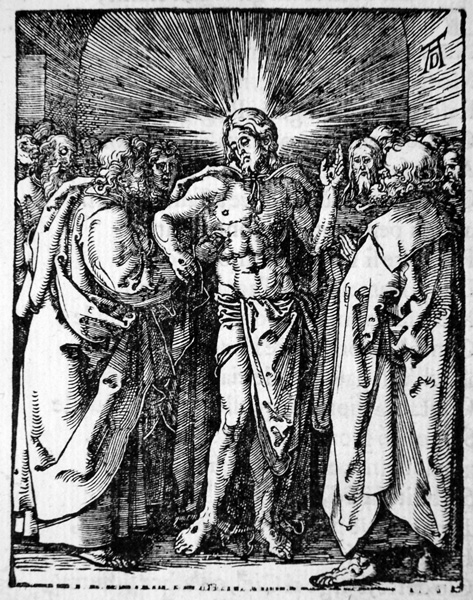 |
|
Christ appears to Thomas (B. 49, S. 133, Meder 158) Original woodcut, c. 1510 for the Small Passion. Our impression is from the Italian edition of 1612 with the Italian text on the verso. The bottom border has a great many breaks in it; Meder calls fot a big gap in the upper right corner. Someone as "fixed" our impression by suplying what is missing in pen. The text underlying this print is John 20: 24-29: "But Thomas (who was called the Twin), one of the twelve, was not with them when Jesus came. So the other disciples told him, 'We have seen the Lord.' But he said to them, 'Unless I see the mark of the nails in his hands, and put my finger in the mark of the nails and my hand in his side, I will not believe.' A week later his disciples were again in the house, and Thomas was with them. Although the doors were shut, Jesus came and stood among them and said, 'Peace be with you.' Then he said to Thomas, 'Put your finger here and see my hands. Reach out your hand and put it in my side. Do not doubt but believe.' Thomas answered him, 'My Lord and my God!' Jesus said to him, 'Have you believed because you have seen me? Blessed are those who have not seen and yet have come to believe.' " Large margins; Signed with the monogram top right; the sheet is marked k 2 in the margin below the woodcut. On the reverse, there is a page of Italian text with the heading ASCENSIONE and lower left a small collector's stamp in red. Old paper hinges at top.Image size: 125x97mm. Price: Please call or email for current pricing information.
|
|
|
|
|
|
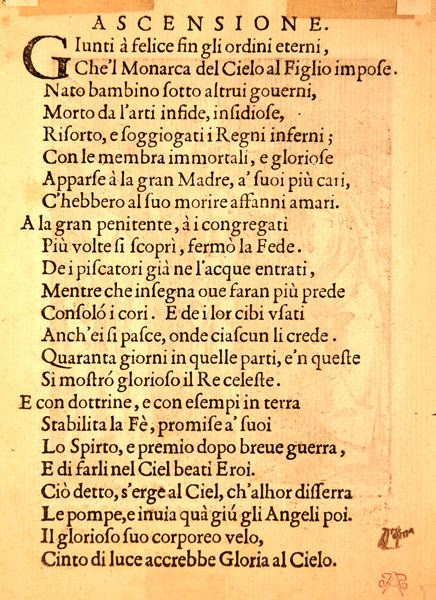 |
|
|
|
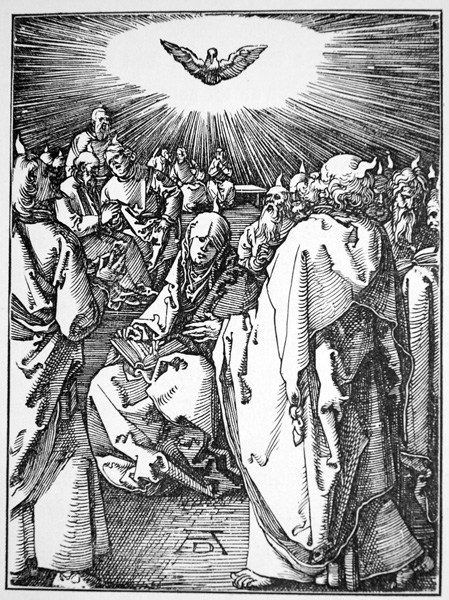 |
|
|
Albrecht Durer (Nuremburg, 1471-1528), Pentecost (Bartsch 51, Strauss 135) Original woodcut, c. 1510 for the Small Passion. In 1844 plaster casts were made from Durer's original woodblocks for the Small Woodcut Passion, which had just been acquired by the British Museum. From these casts, metal plates were made and a small edition produced. Our impression is from this edition. Veronese used this woodcut as a model for his drawing of the Pentecost (click here). Image size: 123x95mm. Price: Please call or email for current pricing information.
|
|
|
|
|
|
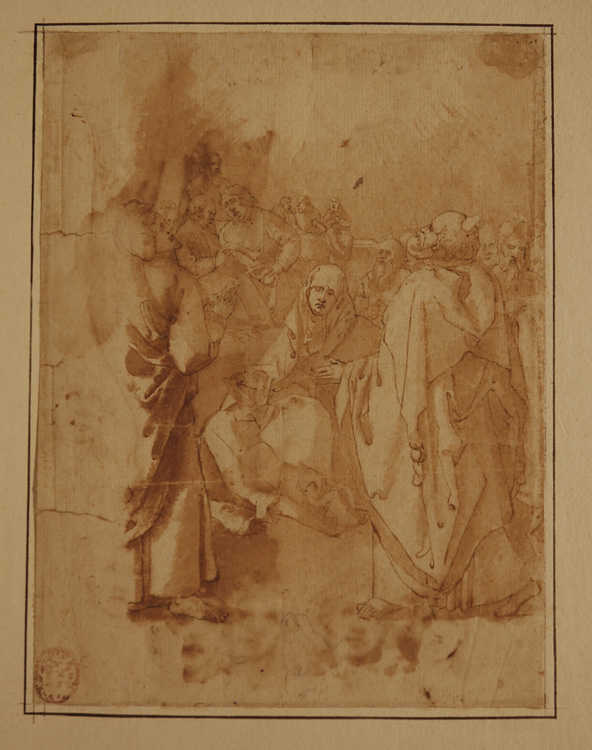 |
|
|
|
Paolo Veronese, attributed, Pentecost. Pen and brown ink and wash on cream laid paper, c. 1545-55?. Old collector's mark lower left. On the verso are 6 studies of heads looking upwards and a study of feet and legs, possibly a study for a crucifixion. The heads show through on the left side and the bottom of this sheet. If one compares this drawing with Durer's Pentecost in the Small Woodcut Passion, it is clear that Veronese was working with it close at hand. Image size: 215x165mm. Price: Please call or email for current pricing information.
Collector's stamp, lower left. While indistinct, the seal appears to feature a crown top center, possibly suggesting that it was once in a ducal, princely, or royal collection. For the verso, please click here.
|
|
|
|
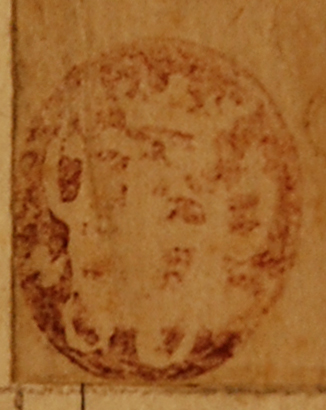 |
|
|
|
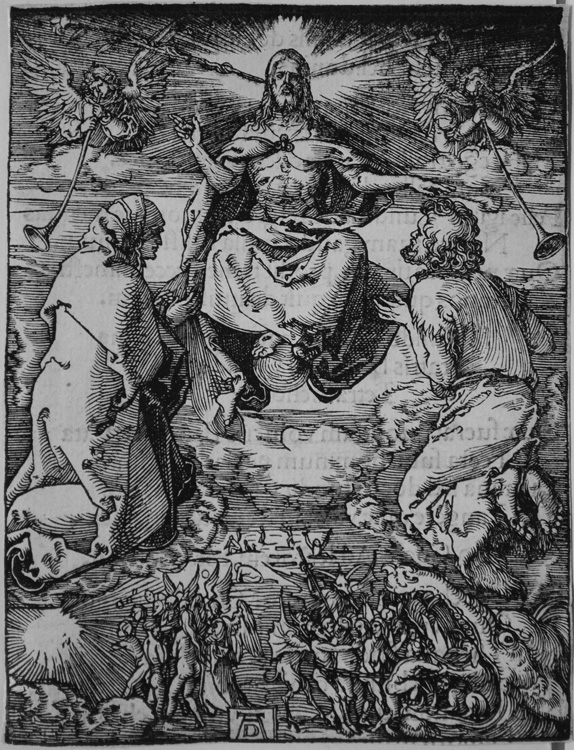 |
|
|
|
The Last Judgment (B. 52, S. 136, M. 161). Original woodcut, c. 1510. A very rich impression from the 1511 first edition with the Latin text on the verso printed on laid paper with an unreadable partial watermark and with wide margins. Two collectors' marks verso along with collection numbers. At the bottom, angels sort the risen into two groups, those on our right enter into a giant gaping mouth to begin there journey to hell; on our left (Jesus' right), angels escort the risen onto the clouds that will lead them to the intense bright light of heaven. In the mid-ground, the graves are opening and the dead are rising; above, the Virgin Mary and John the Baptist, both seen from the rear, frame Jesus, sitting on a rainbow on top of a sphere, who is both inviting with his right hand and pointing away with his left; on either side angels are blowing the trumpets that announce the Last Trump. Signed bottom center in the block. Meder's description of this woodcut notes that from the beginning the upper right of the block was flattened and describes proofs before the 1511 edition with text as: "superb" (Strauss, p. 402); ours is not far from that! Lower left corner partially detached but still present. Image size: 127x97mm. Price: Please call or email for current pricing information.
For the text on the verso, see below.
|
|
|
|
|
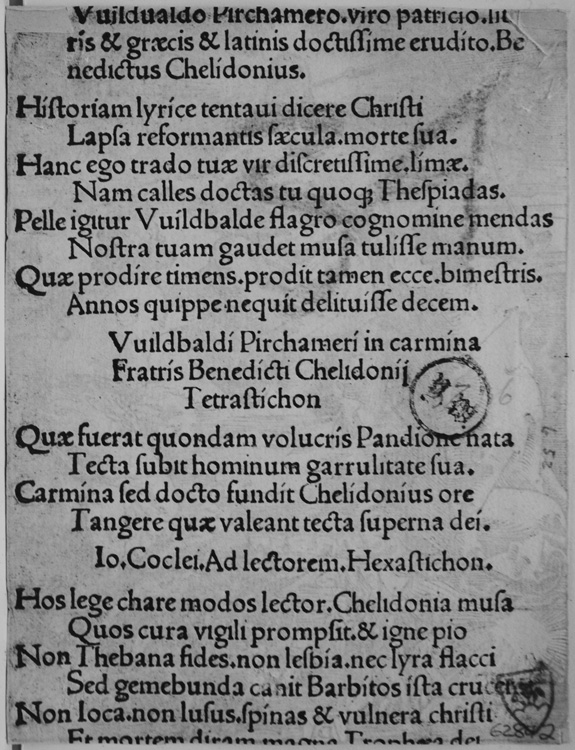 |
|
|
The Last Judgment (B. 52, S. 136, M. 161). Original woodcut, c. 1510. A very rich impression from the 1511 first edition with the Latin text on the verso printed on laid paper with an unreadable partial watermark and with small margins. 2 collector's marks verso along with collection numbers. The text type and layout exactly match those reproduced in the reduced-size facsimile of the 1511 Small Woodcut Passion by Horst Appuhn, Die Kleine Passion von Albrecht Dürer (Dortmund: Harenberg, 1985), p. 82; the only exception is that the bottom half of the last line has been trimmed away.
|
|
|
|
|
|
Spaightwood Galleries, Inc.
To purchase, call us at 1-800-809-3343 (1-508-529-2511 in Upton MA & vicinity) or send an email to spaightwood@gmail.com.
We accept AmericanExpress, DiscoverCard, MasterCard, and Visa.
We also accept wire transfers and paypal.
For directions and visiting information, please call. We are, of course, always available over the web and by telephone (see above for contact information). Click the following for links to past shows and artists. For a visual tour of the gallery, please click here. For information about Andy Weiner and Sonja Hansard-Weiner, please click here. For a list of special offers currently available, see Specials.
All works are sold with an unconditional guarantee of authenticity (as described in our website listing).
Go back to the top of this page.
Visiting hours: Saturday 10:00 am to 5:00 pm and Sunday noon to 6:00 pm and other times by arrangement.
Please call to confirm your visit. Browsers and guests are welcome.
|
|
|
|
|
|
|
|
|
|
|
|
|
|
|
|
|
|
|
|
|
|
|
|
|
|
|
|
|
|
|
|
|
|
|






